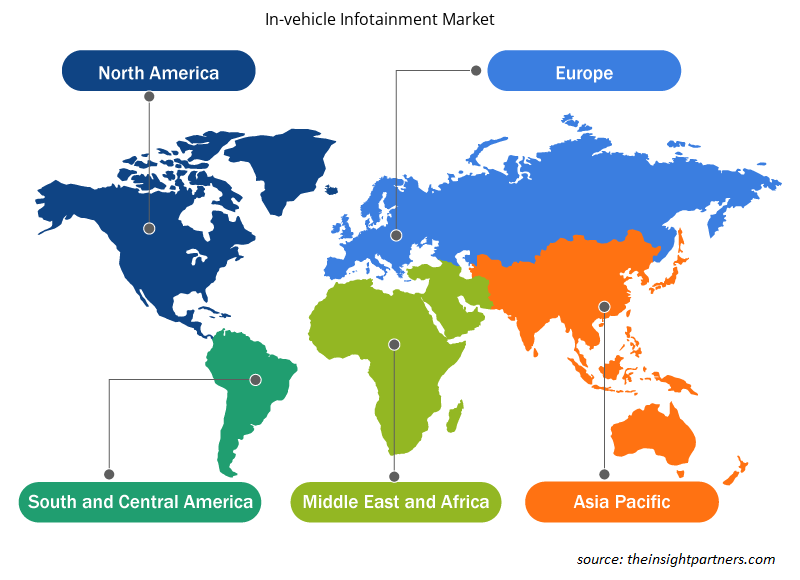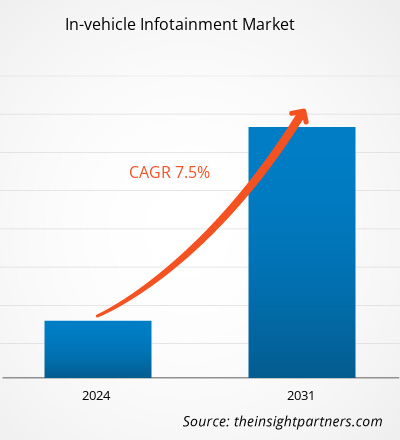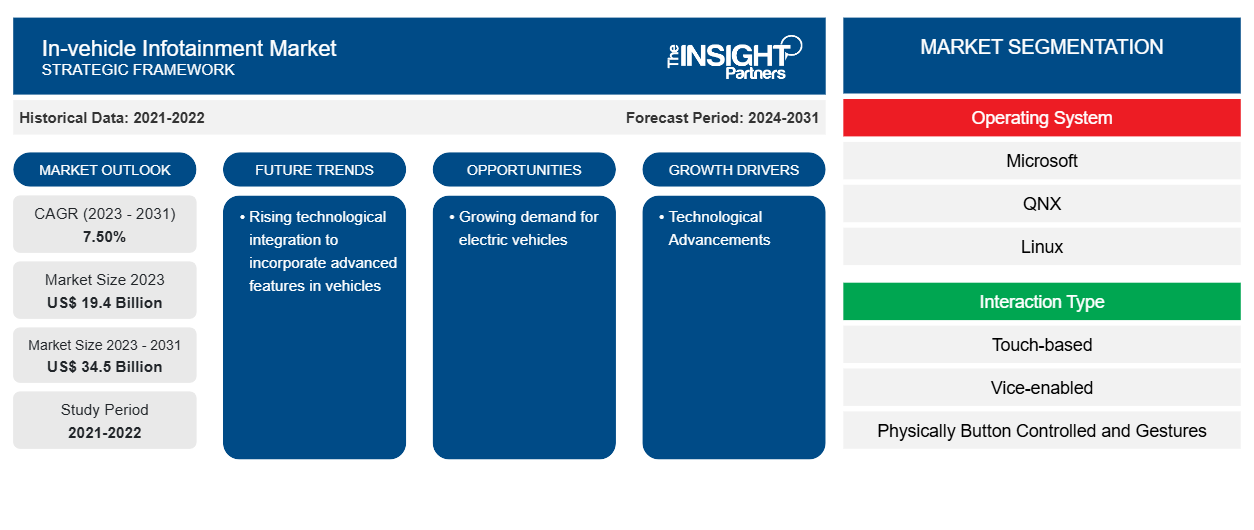Se proyecta que el tamaño del mercado de infoentretenimiento en vehículos alcance los 34.500 millones de dólares en 2031, frente a los 19.400 millones de dólares en 2023. Se espera que el mercado registre una CAGR del 7,50 % entre 2023 y 2031. La integración del sistema avanzado de asistencia al conductor (ADAS) en el sistema de infoentretenimiento es una de las tendencias recientes en la industria. Las funciones ADAS, como las advertencias de cambio de carril, la asistencia de estacionamiento y el control de crucero adaptativo, son algunas de las tendencias recientes en la industria que están generando oportunidades lucrativas.
Análisis del mercado de sistemas de información y entretenimiento en vehículos
El aumento de la producción y las ventas de vehículos de pasajeros es uno de los factores notables que impulsan el crecimiento del mercado de sistemas de información y entretenimiento en vehículos. A nivel mundial, debido al aumento de la urbanización y al aumento de la renta disponible, las ventas de vehículos de pasajeros han aumentado en los últimos años. Según los datos publicados por la Organización Internacional de Constructores de Automóviles en 2023, la producción de turismos a nivel mundial alcanzó los 58 millones de unidades en 2022; sin embargo, en 2023, la producción alcanzó los 65 millones de unidades. Este aumento de la producción y las ventas de vehículos por año está impulsando la demanda del mercado de información y entretenimiento en vehículos.
Panorama del mercado de infoentretenimiento en vehículos
La demanda de sistemas de infoentretenimiento en vehículos en la región de Asia Pacífico ha aumentado en los últimos años, al igual que la demanda de vehículos de pasajeros. La demanda se debe principalmente al aumento de la renta disponible en la región de Asia Pacífico. Según los datos proporcionados por la Organización Internacional de Constructores de Automóviles, en 2023 la producción de turismos en la región fue de 18 millones en 2021, sin embargo, la producción de turismos alcanzó los 24 millones en 2022. Este aumento del volumen de ventas de vehículos ha provocado que la demanda del mercado de infoentretenimiento en vehículos aumente en la región de Asia Pacífico.
Personalice este informe según sus necesidades
Obtendrá personalización en cualquier informe, sin cargo, incluidas partes de este informe o análisis a nivel de país, paquete de datos de Excel, así como también grandes ofertas y descuentos para empresas emergentes y universidades.
-
Obtenga las principales tendencias clave del mercado de este informe.Esta muestra GRATUITA incluirá análisis de datos, desde tendencias del mercado hasta estimaciones y pronósticos.
Factores impulsores y oportunidades del mercado de información y entretenimiento en vehículos
Avances tecnológicos
Uno de los factores más importantes que explican el crecimiento del mercado es el avance tecnológico en el campo de los teléfonos inteligentes y la tecnología en la nube. A medida que la penetración de los teléfonos inteligentes aumentó, muchos fabricantes de sistemas de información y entretenimiento para vehículos comenzaron a ofrecer sistemas que tienen conectividad con teléfonos inteligentes . Además, a medida que surgió el concepto de la tecnología en la nube en el software de información y entretenimiento para vehículos, las empresas comenzaron a utilizar la tecnología en la nube para proporcionar funciones y servicios personalizados. Por lo tanto, debido a la evolución tecnológica en el campo de la información y entretenimiento para vehículos, la demanda de este tipo de sistemas aumentó a nivel mundial.
Integración de Inteligencia Artificial
A medida que aumenta la demanda de vehículos autónomos, los sistemas de información y entretenimiento a bordo evolucionan al mismo tiempo. Además, el número de pantallas en los automóviles de pasajeros también aumenta a medida que aumenta la demanda de entretenimiento y autonomía. Por lo tanto, muchos actores de la industria automotriz se están centrando en integrar la inteligencia artificial en sus automóviles como asistente del conductor.
Análisis de segmentación del informe de mercado de infoentretenimiento en vehículos
Los segmentos clave que contribuyeron a la derivación del análisis del mercado de infoentretenimiento en el vehículo son el sistema operativo, el tipo de interacción y la tecnología de conectividad.
- Según el sistema operativo, el mercado de información y entretenimiento en vehículos se divide en Microsoft, QNX y Linux.QNX, Linux.
- Por tipo de interacción, el mercado se segmenta en táctil, con botón activado, controlado físicamente y por gestos. El segmento táctil tuvo la mayor participación del mercado en 2023.
- En términos de categorías, el mercado se divide en Wi-Fi, Bluetooth y NFC. El segmento Bluetooth dominó el mercado en 2023.
Análisis de la cuota de mercado de los sistemas de información y entretenimiento en vehículos por geografía
El alcance geográfico del informe del mercado de infoentretenimiento en vehículos se divide principalmente en cinco regiones: América del Norte, Asia Pacífico, Europa, Medio Oriente y África, y América del Sur/América del Sur y Central.
El mercado mundial de infoentretenimiento para vehículos está dominado por la región de Asia Pacífico; sin embargo, América del Norte y Europa también son regiones destacadas en la industria. En la región de Asia Pacífico, China se ha convertido en el centro de fabricación de la industria automotriz mundial. Según los datos disponibles en el dominio público, las ventas de automóviles de China experimentaron un crecimiento del 12% en 2023 en comparación con 2022. Además, según las estadísticas recientes, China informó exportaciones de más de 5 millones en 2023. Una industria automotriz tan fuerte en la región de Asia Pacífico aumentó la demanda del sistema de infoentretenimiento para vehículos.
Perspectivas regionales del mercado de infoentretenimiento en vehículos
Los analistas de Insight Partners explicaron en detalle las tendencias y los factores regionales que influyen en el mercado de infoentretenimiento en vehículos durante el período de pronóstico. Esta sección también analiza los segmentos y la geografía del mercado de infoentretenimiento en vehículos en América del Norte, Europa, Asia Pacífico, Oriente Medio y África, y América del Sur y Central.

- Obtenga datos regionales específicos para el mercado de infoentretenimiento en vehículos
Alcance del informe sobre el mercado de infoentretenimiento en vehículos
| Atributo del informe | Detalles |
|---|---|
| Tamaño del mercado en 2023 | US$ 19,4 mil millones |
| Tamaño del mercado en 2031 | US$ 34,5 mil millones |
| CAGR global (2023 - 2031)CAGR (2023 - 2031) | 7,50% |
| Datos históricos | 2021-2022 |
| Período de pronóstico | 2024-2031 |
| Segmentos cubiertos |
Por sistema operativo
|
| Regiones y países cubiertos |
América del norte
|
| Líderes del mercado y perfiles de empresas clave |
|
Densidad de actores del mercado: comprensión de su impacto en la dinámica empresarial
El mercado de infoentretenimiento en vehículos está creciendo rápidamente, impulsado por la creciente demanda de los usuarios finales debido a factores como la evolución de las preferencias de los consumidores, los avances tecnológicos y una mayor conciencia de los beneficios del producto. A medida que aumenta la demanda, las empresas amplían sus ofertas, innovan para satisfacer las necesidades de los consumidores y aprovechan las tendencias emergentes, lo que impulsa aún más el crecimiento del mercado.
La densidad de actores del mercado se refiere a la distribución de las empresas o firmas que operan dentro de un mercado o industria en particular. Indica cuántos competidores (actores del mercado) están presentes en un espacio de mercado determinado en relación con su tamaño o valor total de mercado.
Las principales empresas que operan en el mercado de infoentretenimiento en vehículos son:
- Electrónica Alpine, Inc.
- Compañía Clarion Co., Ltd.
- Continental AG
- Denso Ten Limited
- Garmin Ltd.
- Harman Internacional
Descargo de responsabilidad : Las empresas enumeradas anteriormente no están clasificadas en ningún orden particular.

- Obtenga una descripción general de los principales actores clave del mercado de infoentretenimiento en vehículos
Noticias y desarrollos recientes del mercado de infoentretenimiento en vehículos
El mercado de infoentretenimiento en vehículos se evalúa mediante la recopilación de datos cualitativos y cuantitativos posteriores a la investigación primaria y secundaria, que incluye publicaciones corporativas importantes, datos de asociaciones y bases de datos. A continuación, se incluye una lista de los avances en el mercado de infoentretenimiento en vehículos y las estrategias:
- Snapp Automotive lanzó el sistema de información y entretenimiento automotriz Android. SnappOS es un sistema de información y entretenimiento personalizable, contextual e inteligente que permite ciclos de desarrollo rápidos e implementación en entornos reales o simulados. (Fuente: Snapp Automotive, comunicado de prensa/sitio web de la empresa/boletín informativo, 2022)
- Panasonic Automotive System anunció una actualización para su sistema de información y entretenimiento en el vehículo (IVI) SkipGen, que brinda acceso a Siri o Alexa. (Fuente: Panasonic Automotive System, comunicado de prensa/sitio web de la empresa/boletín informativo, 2023)
Informe sobre el mercado de infoentretenimiento en vehículos: cobertura y resultados
El informe “Tamaño y pronóstico del mercado de infoentretenimiento en vehículos (2021-2031)” proporciona un análisis detallado del mercado que cubre las siguientes áreas:
- Tamaño del mercado y pronóstico a nivel global, regional y nacional para todos los segmentos clave del mercado cubiertos bajo el alcance
- Dinámica del mercado, como impulsores, restricciones y oportunidades clave
- Principales tendencias futuras
- Análisis detallado de las cinco fuerzas de Porter y PEST y FODA
- Análisis del mercado global y regional que cubre las tendencias clave del mercado, los principales actores, las regulaciones y los desarrollos recientes del mercado.
- Análisis del panorama de la industria y de la competencia que abarca la concentración del mercado, el análisis de mapas de calor, los actores destacados y los desarrollos recientes
- Perfiles detallados de empresas
- Análisis histórico (2 años), año base, pronóstico (7 años) con CAGR
- Análisis PEST y FODA
- Tamaño del mercado, valor/volumen: global, regional y nacional
- Industria y panorama competitivo
- Conjunto de datos de Excel
Informes recientes
Informes relacionados
Testimonios
Razón para comprar
- Toma de decisiones informada
- Comprensión de la dinámica del mercado
- Análisis competitivo
- Información sobre clientes
- Pronósticos del mercado
- Mitigación de riesgos
- Planificación estratégica
- Justificación de la inversión
- Identificación de mercados emergentes
- Mejora de las estrategias de marketing
- Impulso de la eficiencia operativa
- Alineación con las tendencias regulatorias























 Obtenga una muestra gratuita para - Mercado de infoentretenimiento en vehículos
Obtenga una muestra gratuita para - Mercado de infoentretenimiento en vehículos